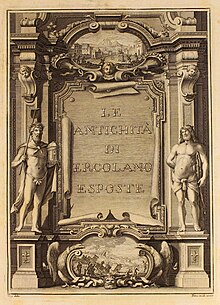
The Villa of the Papyri is named after its unique library of papyri, discovered in 1750, but is also one of the most luxurious houses in all of Herculaneum and in the Roman world. Its luxury is shown by its exquisite architecture and by the very large number of outstanding works of art discovered, including frescoes, bronzes and marble sculpture which constitute the largest collection of Greek and Roman sculptures ever discovered in a single context.

The Last Day of Pompeii is a large history painting by Karl Bryullov produced in 1830–1833 on the subject of the eruption of Mount Vesuvius in AD 79. It is notable for its positioning between Neoclassicism, the predominant style in Russia at the time, and Romanticism as increasingly practised in France. The painting was received to near universal acclaim and made Bryullov the first Russian painter to have an international reputation. In Russia it was seen as proving that Russian art was as good as art practised in the rest of Europe. Critics in France and Russia both noted, however, that the perfection of the classically modelled bodies seemed to be out of keeping with their desperate plight and the overall theme of the painting, which was a Romantic one of the sublime power of nature to destroy man's creations.

The National Archaeological Museum of Naples is an important Italian archaeological museum, particularly for ancient Roman remains. Its collection includes works from Greek, Roman and Renaissance times, and especially Roman artifacts from nearby Pompeii, Stabiae and Herculaneum. It was formerly the Real Museo Borbonico.

The Secret Museum or Secret Cabinet of Naples is the collection of erotic art in Pompeii and Herculaneum, held in separate galleries in the National Archaeological Museum, Naples, Italy, the former Museo Borbonico. "Cabinet" refers to a cabinet of curiosities, a well-presented collection of objects to admire and study.
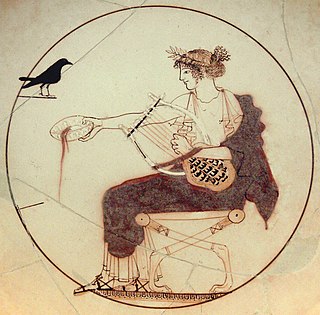
The chelys, was a stringed musical instrument, the common lyre of the ancient Greeks, which had a convex back of tortoiseshell or of wood shaped like the shell. The word chelys was used in allusion to the oldest lyre of the Greeks, which was said to have been invented by Hermes. According to the Homeric Hymn to Hermes, he came across a tortoise near the threshold of his mother's home and decided to hollow out the shell to make the soundbox of an instrument with seven strings.
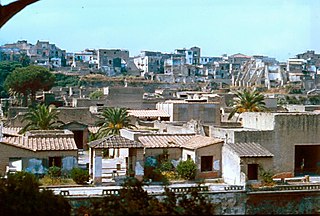
Ercolano[erkoˈlaːno] is a town and comune in the Metropolitan City of Naples, Campania of Southern Italy. It lies at the western foot of Mount Vesuvius, on the Bay of Naples, just southeast of the city of Naples. The medieval town of Resina - read Resìna - was built on the volcanic material left by the eruption of Vesuvius that destroyed the ancient city of Herculaneum, from which the present name is derived. Ercolano is a resort and the starting point for excursions to the excavations of Herculaneum and for the ascent of Vesuvius by bus. The town also manufactures leather goods, buttons, glass, and the wine known as Lacryma Christi.

The Villa Poppaea is an ancient Roman seaside villa situated between Naples and Sorrento, in southern Italy. It is also called the Villa Oplontis or Oplontis Villa A by modern archaeologists. The villa itself is a large structure situated in the ancient Roman town of Oplontis, about ten metres below modern ground level. Evidence suggests that it was owned by the Emperor Nero, and it is believed to have been used by his second wife, Poppaea Sabina, as her main residence when she was not in Rome.

Pompeii and Herculaneum were once thriving towns, 2,000 years ago, in the Bay of Naples. Though both cities have rich histories influenced by Greeks, Oscans, Etruscans, Samnites and finally the Romans, they are most renowned for their destruction: both were buried in the AD 79 eruption of Mount Vesuvius. For over 1,500 years, these cities were left in remarkable states of preservation underneath volcanic ash, mud and rubble. The eruption completely obliterated the towns but ironically was the cause of their longevity and survival over the centuries.
Karl Jakob Weber was a Swiss architect and engineer who was in charge of the first organized excavations at Herculaneum, Pompeii and Stabiae, under the patronage of Charles III of Naples. At first a soldier and military engineer, he joined the excavations in 1749. His detailed drawings provided some of the basis for the luxurious royal folios of Le Antichità di Ercolano esposte, by means of which the European intelligentsia became aware of the details of what was being recovered.

Francesco Piranesi was an Italian engraver, etcher and architect. He was the son of the more famous Giovanni Battista Piranesi and continued his series of engravings representing monuments and ancient temples. He worked for a long period in France, where he lived during the French Revolution.

The bronze Seated Hermes, found at the Villa of the Papyri in Herculaneum in 1758, is at the National Archaeological Museum of Naples. "This statue was probably the most celebrated work of art discovered at Herculaneum and Pompeii in the eighteenth century", Francis Haskell and Nicholas Penny have observed, once four large engravings reproducing it had appeared in Le Antichità di Ercolano, 1771. To protect it from Napoleonic depredations, it was packed into one of the fifty-two cases of antiquities and works of art that accompanied the Bourbon flight to Palermo in 1798. It was once again in the royal villa at Portici in 1816.
The decade of the 1740s in archaeology involved some significant events.
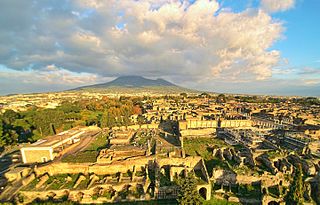
Pompeii was an ancient Roman city near modern Naples in the Campania region of Italy, in the territory of the comune of Pompei. Pompeii, along with Herculaneum and many villas in the surrounding area, was buried under 4 to 6 m of volcanic ash and pumice in the eruption of Mount Vesuvius in AD 79. Volcanic ash typically buried inhabitants who did not escape the lethal effects of the earthquake and eruption.
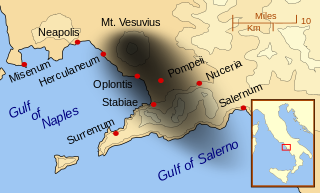
Oplontis is an ancient Roman archaeological site located in the middle of the city of Torre Annunziata, which is south of Naples in the Campania region of southern Italy..The name "Oplontis" most likely referred originally to the baths in the area of Campo Oncino. The site comprises two Roman villas, the best-known of which is the so-called Villa Poppaea. Like the nearby towns of Pompeii and Herculaneum, Oplontis was buried in ash and lava during the volcanic eruption of Mount Vesuvius in A.D. 79.

The Royal Palace of Portici is a former royal palace in Portici, Southeast of Naples along the coast, in the region of Campania, Italy. Today it is the home of the Orto Botanico di Portici, a Botanic Gardens are operated by the University of Naples Federico II. These gardens were once part of the large royal estate that included an English garden, a zoo and formal parterres.

Marco De Gregorio was an Italian painter, who would form part of the School of Resina, painting works that spanned the spectrum from historical to genre topics.
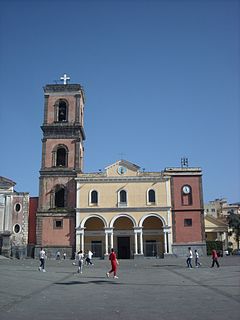
The Basilica of Santa Maria a Pugliano is the main church in Ercolano and the oldest church in the area around Mount Vesuvius.

Camillo Paderni, or Camillus Paderni, lived from ca. 1715-1781, he was a illustrator, excavator, and curator at the Museum Herculanense, as part of King Charles VII of Naples royal Palace in Portici, and a Roman.
